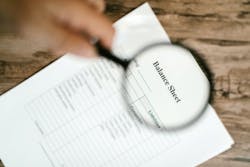Finance was definitely my Achilles’ heel in owning shops. After selling my shops last year I’ve had a lot of time to reflect on what I would do differently. Getting a stronger understanding of business finance in general and a better grasp on my financials would likely be in the top three.
Here are a few things that I learned the hard way.
From my grandpa, I learned the old adage: “If you aim at nothing, you will certainly hit it.” For many years I was flying blind. I had no idea what I was even aiming for. Instead, I would just land a repair, do the work, deliver it and hope for the best. Then I would pay my bills as they came in. Often there was more month than money. I thought I could fix that with more sales. Turns out if you have holes in your pockets no matter how much money you put in there it will just keep falling out! Growing sales was not the answer. The answer was in some advice my dad kept trying to teach me.
Dad told me over and over, “It’s not what you make, it’s what you keep!” I was making money. It just wasn’t sticking around for long! In the process of trying to fix everything with sales, I learned a lot about how to make money. Keeping money was actually much harder to master.
What eventually tied it all together was having a scorecard that I held myself and my team accountable to. It’s those KPIs—key performance indicators—that we hear so much about. At first, it seemed all so confusing. Which numbers were important? There was so much data coming at me from my accountant, from our estimating software, from insurance and rental car companies. I had to simplify it and get down to just a handful of measurables. At first, we had a weekly leadership meeting and our scorecard had 12 items on it. Eventually we landed on just a few that we measured weekly and a few that we measured monthly. Once you start working on it you’ll likely find as we did that less is more. Having a handful of measures is not only easier, it's better and creates more cohesion and a focus for you and your team.
Another simple tool is job costing. I learned to go into any RO and quickly audit it by checking what money was coming in on a job (the revenue) and what was going out (labor, parts, paint, sublet, materials). Most estimating software has this built-in now. For a while, I did it manually with a cover sheet I put on each job. Eventually, with management software layered on top of the estimating software, it became a point-and-click report. I am grateful though that I learned it manually as it forced me to understand job costing in a deeper way. And something that a manager taught me was that job costing was like a mini profit and loss statement on each job. That meant that our monthly profit and loss statement from our bookkeeping software was basically all those jobs rolled up into a month.
One thing that job costing did not account for though was the fixed costs. So let’s look a bit deeper at the profit and loss statement. Profit and loss statements have three main components.
- Revenue, i.e. sales, all the money that comes in.
- Expenses, both fixed expenses you would have whether you fix one car or not (e.g. mortgage, electricity, insurance, etc.), and variable costs (like labor on a job, paint, parts, sublet, etc.).
- Profit or loss, taking your income and subtracting your expenses.
I’m keenly aware that this is a major simplification and most owners and managers will have a handle on this. However, I wish someone had “dumbed it down” for me in my first few years and then added all the nuance later after I had a strong grasp on the basics. If you do already have a handle on this, perhaps this will be helpful to someone you are training or who is just starting out. Later they can learn all the nuances of net operating income, EBITDA, and net profit. But at its most basic a P&L is simply Revenue - Expenses = Profit.
I’ll close with a simple checklist of things to be on top of that will help you steer your shop toward clarity and profitability:
- Do you review a monthly P&L and balance sheet?
- Do you have a handful of KPIs that you and your team are clear on and accountable to?
- Do you operate from a budget?
- Are your reports accurate and timely?
- Are you keeping up with your taxes and have a strategy to minimize your tax burden?
If you have a handle on all the above you will be able to pinpoint opportunities to reduce expenses and increase profitability. And if you’re like me, I hope you learn much faster than I did that, “It’s not what you make, it’s what you keep.” Thanks, dad.
About the Author

Kevin Rains
Kevin Rains is the owner of Rains CARSTAR Group with locations in Cincinnati, Ohio; West Chester, Ohio; and Lexington, Kentucky. He is also an industry consultant. He can be reached at [email protected].
